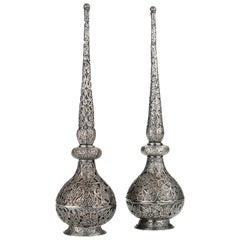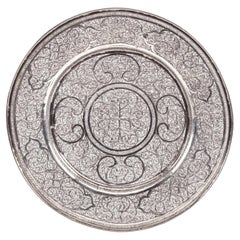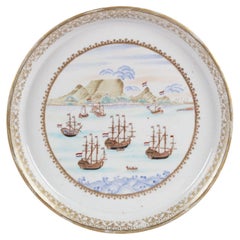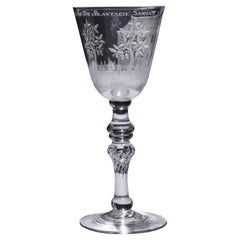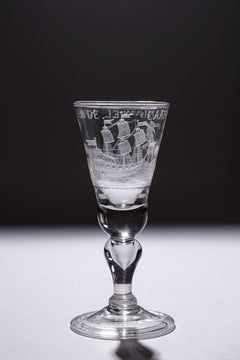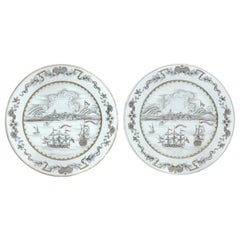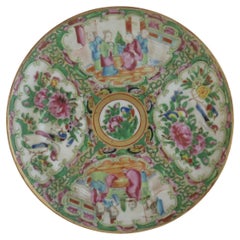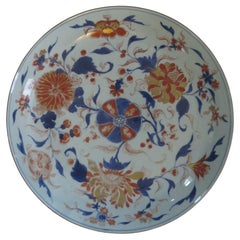Zebregs&Röell Serveware, Ceramics, Silver and Glass
to
17
14
2
1
1
1
11
9
4
4
3
17
11
7
4
3
3
17
17
17
Pair of Fine Islamic Silver Filigree Rosewater Sprinklers, Early 18th Century
Located in Amsterdam, NL
A pair of very fine silver filigree rosewater sprinklers
Possibly India, Karimnagar, early 18th century
Height 31.6 cm and 31.7 cm, weight 39...
Category
Antique Early 18th Century Indian Islamic Metalwork
Materials
Silver
Splendid and Heavy Late 17th Century Dutch-Colonial Silver Filigree Salver
Located in Amsterdam, NL
A splendid and heavy Dutch-colonial silver filigree salver
Indonesia, Batavia (Jakarta) or possibly Padang, West Sumatra, 2nd half 17th century
Diam. 22.9 cm
Weight 551 grams
This filigree-work was probably done by Chinese masters...
Category
Antique 17th Century Indonesian Dutch Colonial Metalwork
Materials
Silver
Rare Large Chinese Export Porcelain 'Table Bay' Cape of Good Hope Dish, C. 1740
Located in Amsterdam, NL
A rare large Chinese export porcelain 'Table Bay' dish
Qianlong period, circa 1735-1750
Diam. 27.5 cm
This version of the ‘Table Bay’ porcelain docu...
Category
Antique Mid-18th Century Chinese Chinese Export Ceramics
Materials
Porcelain
Engraved Commemorative Surinam Plantation Glass, History of 18th Century Slavery
Located in Amsterdam, NL
A splendid commemorating glass with a fine engraving of a plantation house and coffee shrubs with a text reading: Het.Welvaaren.Van.De.Plantagie.Saxen (the prosperity of the Plantati...
Category
Antique Mid-18th Century Surinamer Glass
Materials
Glass
Engraved 'Cape of Good Hope' Colonial Commemorative Glass, 18th Century
Located in Amsterdam, NL
A commemorating glass with an engraving of a farmer ploughing, an East Indiaman and a text reading:
Het Lan’s Wel Varen An De Caap (the country’s prosperity at the Cape of Good Hope...
Category
Antique 18th Century South African Glass
Materials
Glass
Rare Pair of Chinese Export Porcelain 'Table Bay' or 'Cape of Good Hope' Plates
Located in Amsterdam, NL
An extremely rare pair of Chinese export porcelain ‘Table Bay’ or 'Cape of Good Hope' dishes
Qianlong period, mid-18th century
Measure: Diameter. 23.8 ...
Category
Antique Mid-18th Century Chinese Ceramics
Materials
Porcelain
Pair of Fine Japanese Export Lacquer Cutlery Knife Boxes, 18th Century
Located in Amsterdam, NL
A pair of fine Japanese export lacquered cutlery boxes
Kyoto or Nagasaki, late 18th century
H. 33.5 x W. 24 x D. 21 cm
The bow-fronted boxes with sloping lids flat at the top are made of hinoki wood (Cypress), coated with Japanese paper and decorated in lacquer with scattered gold birds and flowers on a nashiji background. The Japanese mounts are made of copper and both boxes still have internal partitions to keep the cutlery upright.
The form of these boxes is similar to a pictorial-style knife box in the collection of the Groninger Museum (inv. 1989- 347), dated between 1730 and 1780, but the style of the decoration is more like that on a knife box in the Peabody Essex Museum in Salem (inv. E62271), which was brought to Salem by James Devereux, Captain of the Franklin, in 1799.
Provenance:
Henriette Jeane Christine van Neukirchen, called Nyvenheim (1807- 1849) and Nicolaas Johan Steengracht van Oostcapelle (1806-1866), thence by descent to the last owners, Ludolphine Emilie baronesse Schimmelpenninck van der Oye (1944) married in 1969 to Roland Daniel van Haersma Buma (1944), the last residents of castle Duivenvoorden near Voorschoten and the great-great-granddaughter of Nicolaas Johan Steengracht van Oostcapelle.
There is no evidence that Nicolaas Johan himself, or any of his or his wife’s ancestors had ever been in Japan. However, Nicolaas’ grandfather (Nicolaas Steengracht, 1754-1840) was a director of both the VOC and WIC (West Indies Company...
Category
Antique Late 18th Century Japanese Lacquer
Materials
Silver
Pair of Japanese Lacquer and Mother-of-Pearl Inlaid Knife Urns, circa 1800-1815
Located in Amsterdam, NL
A rare pair of Kyoto-Nagasaki style lacquer and mother-of-pearl inlaid knife urns
Edo period, early 19th century
Measures: Height 71 x diameter 30 cm
?Formed as urns with vertically lifting covers and elongated finials, revealing fitted green velvet lined interiors for knives, decorated overall with birds, flowering stems, faux-fluting and oval panels with landscapes. The square plinth is raised on four bracket feet. Inside the lifting cover of one of the urns are Japanese characters, supposedly indications of some code by the craftsman.
A closely related knife urn, now in the collection of the Peabody Essex Museum, Salem (inv. E 73115), was acquired in Nagasaki by Captain Samuel Gardner Derby of the Margareth of Salem in 1801. Captain Gardner Derby traded in Nagasaki under charter from the VOC (Vereenigde Oostindische Compagnie), the Dutch East India Company. Between 1797 and 1814 Holland was occupied by the French and from 1811 until 1816 Java by
the English. During these periods practically no Dutch shipping was possible between Holland and Batavia (Jakarta) or between Batavia (Jakarta) and Nagasaki. To maintain a minimum amount of shipping between Batavia (Jakarta) and Nagasaki, between 1797 and 1807, the VOC chartered mainly American ships. American captains and officers ordered and bought mainly lacquered furniture in an American-English style, completely different from what the Dutch up till then had ordered. The present knife urns were possibly also ordered and acquired by Captain Gardner Derby during his stay in Deshima/Nagasaki in 1801.
Another similarly neoclassical shaped knife urn in the collection of the Ashmolean Museum Oxford (inv. 1996.17) appears to be signed by woodworker Kiyotomo koreo tsukuru (Kiyomoto made this). The same name, together with an address in the Sanjo-Teramachi District of Kyoto, has been found inside a fragmentary urn in a private collection. This is an indication that European-style furniture was not only lacquered in Japan but made there as well. This undoubtedly is not only true for knife-urns, but all European- style furniture lacquered in Japan after circa 1800 was made by Japanese furniture makers...
Category
Antique Early 19th Century Japanese Anglo-Japanese Lacquer
Materials
Brass
Large 17th Century Colonial Japanese Porcelain VOC Charger
Located in Amsterdam, NL
A Japanese Arita blue and white porcelain VOC dish.
Arita, late 17th century
Measure: Diameter 32.1 cm
These dishes, ordered by the VOC during the second half of the 17th century, were copied after the popular Chinese Wanli ‘Kraak’ porcelain...
Category
Antique Late 17th Century Japanese Ceramics
Materials
Porcelain
Two Chinese Porcelain Kangxi 'Pelgrom' Armorial Chargers, circa 1710
Located in Amsterdam, NL
A pair of very large Chinese armorial export blue and white porcelain 'Pelgrom' chargers
Kangxi period, circa 1710
The two chargers, decorated in...
Category
Antique Early 18th Century Chinese Chinese Export Ceramics
Materials
Porcelain
Fabulous Indonesian Yogya-Silver Plate
Located in Amsterdam, NL
An Indonesian Yogya-silver plate
Yogyakarta or Kotagede, 1935-1940, marked, (alloy) 800 and maker’s mark PH (Prawirohardjo, act. from 1935)
Diam. 27.2 cm Weight 454 grams
Th...
Category
Early 20th Century Indonesian Art Deco Sterling Silver
Materials
Silver
Rare Dutch Caribbean Silver Water-Scoop Curaçao, circa 1873
Located in Amsterdam, NL
A rare Dutch Caribbean silver water-scoop
Curaçao, circa 1873, indistinctly marked, engraved with initials G R P
Measures: L 35 cm, weight 221 gr...
Category
Antique 19th Century Caribbean Dutch Colonial Sterling Silver
Materials
Silver
Dutch Colonial Silver Dish with the Von Pfeffel Coat-of-arms, 17th Century
Located in Amsterdam, NL
An unusual Indonesian lobbed silver dish
Jakarta (Batavia) or Coromandel coast, third quarter 17th century, apparently unmarked
The eight lobbed dish exuberantly decorated with floral motifs, with the middle section replaced, consisting of indistinctly marked German silver from the early 19th century, bearing the coat-of-arms of the Von Pfeffel family.
Diam. 30.5 cm
Weight 461 grams
Note:
Lobbed silver dishes with exuberant floral decorations were characteristic of the decorative arts in the Netherlands in the first half of the 17th century. This style of floral decoration was adopted by silversmiths as well as by furniture makers working on the Coromandel Coast and in Batavia, often by workers who had fled the Coromandel Coast because of war and famine. In Batavia this style was known as “Custwerck” (work from the Bengal coast).
These lobbed dishes are seldom marked. Only after 1667 the use of the town mark became obligatory in Batavia but only for silver made in Batavia not for silver imported in Batavia from other VOC settlements. The engraved coat of arms in the centre is a replacement of the original centre.
The coat of arms can be identified as those of Christian Hubert von Pfeffel (1765- 1834). As a diplomat, statesman, ambassador of Bavaria in London and Saxony and councillor to the King of Bavaria, he was made “Freiherr” in 1828 and since then used this coat of arms. His son Karl Maximilian Friederich Hubert Freiherr von Pfeffel (1811-1890) in 1836 married Karoline Adelheid Pauline von Rottenburg (1805-1872), the natural daughter of Prins Paul von Württemberg (1785-1852) and his mistress Margrethe Porth. Paul was the jounger brother of the King Wilhelm I of Württemberg (1781-1864). The heraldic motto of the von Pfeffels Vur Schande habe den Huot means as much as “Beware of Shame”. Christian Hubert Theodoor Marie Karl von Pfeffel Karl Maximilian’s grandson was the last male in the von Pfeffel line. His daughter, Marie Louise (Paris in 1882 - Cornwall 1944), born and grown-up in France, changed her name in de Pfeffel. She was the great grandmother of Boris Alexander de Pfeffel Johnson, the present British Secretary of State. None of the members of the von Pfeffel family had any direct links with the Dutch East Indies but indirectly by way of the Royal House of Württemberg they did.
Sophia Frederika Mathilda von Württemberg (1818-1877), daughter of Wilhelm I King of Württemberg, in 1839 married Willem III...
Category
Antique Late 17th Century Indonesian Dutch Colonial Sterling Silver
Materials
Silver
Fine 17th Century Dutch Colonial Armorial Tortoiseshell & Silver Box, Dated 1691
Located in Amsterdam, NL
A dutch tortoiseshell box with two engraved silver plaques
Amsterdam, 1691, with maker's mark of Steven des Rousseaux (1654-1733)
H. 5 cm
Diam. 12.5 cm
Note:
Steven des ...
Category
Antique 17th Century Dutch Sterling Silver
Materials
Sterling Silver
Rare Chinese Tonkin Ware Cup-and-Saucer, Early 18th Century
Located in Amsterdam, NL
A Chinese made tonkin ware gilt- and lacquer cup and saucer
China or Japan, Chinese artisans, early 18th century
The black-lacquered cup with gilt handles in the shape of sculptured chrysanthemums and a lobbed edge decorated with gilt engraved border, with a gilt foot-ring that fits into the saucer ring, with two cartouches showing partly undercut gilt relief trees and birds on a gilt granulated background, black lacquered bracket-lobed edge, depicting gilt engraved peony scrolls and three cartouches decorated with high relief gilt trees and birds on a gilt granulated background, the centre with engraved chrysanthemum, enclosed by a raised ring upon which the cup fits, around which a circular panel decorated with high gilt relief trees, flowers, birds and a butterfly on a gilt granulated background.
Measures: Cup: H. 5.7 x W. 8.5 cm
Saucer: Diameter 13 cm
Provenance:
Collection Felix Schäfer
Note:
The decoration of the cup and saucer is identical to the slightly smaller cup and saucer...
Category
Antique Early 18th Century Chinese Chinese Export Metalwork
Materials
Other
Colonial Silver VOC 'East-India Company' Ingot
Located in Amsterdam, NL
A silver 'V.O.C. AMSTERDAM' ingot
circa 1738, with monogram and the assay mark of the Amsterdam Grill family
With V.O.C. monogram and the A for Amsterdam.
L. approx. 15.5 cm
Weight approx. 2000 grams
Note:
The ingots were salvaged in 2004 from the wreck of the VOC indiaman Rooswijk, equipped by the Amsterdam VOC Chamber. The Rooswijk sank on its second voyage to the Dutch East Indies off the English coast on the Goodwin Sands...
Category
Antique 18th Century Dutch Historical Memorabilia
Materials
Sterling Silver
$15,566 / item
Rare 17th Century Silver Reliquary Arm Monstrance
Located in Amsterdam, NL
A rare silver reliquary arm with relic bone, with the coat-of-arms of Cosme Roger (1671-1710), bishop of Lombez, France, with original bone relic
Poss...
Category
Antique Late 17th Century Italian Renaissance Religious Items
Materials
Sterling Silver
Related Items
Chinese Export Porcelain Plate Rose Medallion Hand Painted, Qing, circa 1875
Located in Lincoln, Lincolnshire
This is a very decorative Chinese Export, porcelain, Rose Medallion dish or plate which we date to the 19th century, Qing dynasty, circa 1875.
I...
Category
Antique 19th Century Chinese Chinese Export Ceramics
Materials
Porcelain
$292 Sale Price
25% Off
H 0.75 in Dm 7.9 in
Chinese Kangxi mark & period Very Large Imari Dish or Plate Porcelain, Ca 1710
Located in Lincoln, Lincolnshire
This is a very beautifully hand painted Chinese Imari porcelain very large Dish or Plate / Platter from the Qing, Kangxi period, 1662-1722, dating to Circa 1710.
Very large diameter...
Category
Antique Late 17th Century Chinese Qing Ceramics
Materials
Porcelain
$1,303
H 2.25 in Dm 14.7 in
Chinese Export Silver Dragon Spoon by Wang Hing & Co., Late 19th Century
By Wang Hing & Co.
Located in Austin, TX
A very fine and charming Chinese export silver spoon in the form of a dragon, by Wang Hing & Co., Qing Dynasty, late 19th century, China.
...
Category
Antique 1890s Chinese Chinese Export Metalwork
Materials
Silver
$1,200
H 0.88 in W 5 in D 1 in
Chinese Export Porcelain Lotus Leaf-Shaped Dish
Located in Downingtown, PA
Chinese Export Porcelain Lotus Leaf Shaped Dish,
Circa 1765
The large Chinese Export “famille rose” porcelain saucer dish is made in the form of a lotus leaf with the rim and border...
Category
Antique Mid-18th Century Chinese Chinese Export Porcelain
Materials
Porcelain
Chinese Export Famille Rose Porcelain Plate
Located in Astoria, NY
Chinese Export Famille Rose Porcelain Plate, with hand-painted central landscape scene with a peacock and flowers encircled by a scrolling floral border. 9" Diameter x 1.25" H. P...
Category
Antique Late 19th Century Chinese Qing Ceramics
Materials
Porcelain
Antique Chinese Export Porcelain Rose Mandarin Plate
Located in Philadelphia, PA
A fine antique Chinese export porcelain plate.
In the Rose Mandarin style.
Depicting an Imperial court scene. The man on the right is either a servant/government official come to v...
Category
Antique 19th Century Chinese Chinese Export Ceramics
Materials
Porcelain
18th Century Chinese Plate or Bowl Blue & White, Qing Qianlong Circa 1770
Located in Lincoln, Lincolnshire
This is a good Chinese porcelain circular deep plate or soup bowl made for the export (Canton) market, during the middle of the 18th century, Qing-Qianlong period.
The plate is well...
Category
Antique 18th Century Chinese Chinese Export Ceramics
Materials
Porcelain
$368 Sale Price
23% Off
H 1.75 in Dm 9.3 in
Pair of Chinese Export Porcelain Lamps
Located in Lambertville, NJ
A pair of hand painted Chinese porcelain lamps with simple carved wood bases. These are in a classic Rose Medallion pattern. The wiring is in great condition and ready to use. The sh...
Category
Mid-20th Century Chinese Chinese Export Table Lamps
Materials
Porcelain
Antique Islamic Brass Bowl Fine Metalwork Hand Etched Bowl
Located in North Hollywood, CA
Antique Middle Eastern Islamic art Moorish brass bowl engraved with Thuluth Arabic calligraphy.The polished brass bowl is profusely chased with vines and vegetal motifs and inscribed with Islamic verses of the Holly Koran.This bowl has been professionally cleaned and polished.Measures: Diameter 7.25" x 4" height Mouth opening: 5".Great Middle Eastern brass metalwork decorative Islamic art objects.Handcrafted Moorish hand-etched Islamic metal brass bowl.Engraved, incised and hammered with very fine Arabic Islamic calligraphy writing and geometric designs on brass vessel.Very Intricate fine Middle eastern Moorish Islamic Art metalwork, museum quality artwork.Late 19th Century.Date of Manufacture: Circa 1880.Condition: Wear consistent with age and use.
Islamic brass metalwork is an intricate and beautiful form of art that originated in the Islamic world. It encompasses a wide range of decorative objects made from brass or other metals such as copper, bronze, and silver. Brass trays, in particular, are highly regarded for their craftsmanship and intricate designs.
Islamic brass metalwork has a rich history that dates back to the early Islamic period, with its roots in the metalworking traditions of ancient civilizations such as the Persians, Greeks, and Romans. However, Islamic artisans developed their own unique styles and techniques, blending elements from various cultures and creating distinctive motifs that reflected Islamic aesthetics and religious beliefs.
The process of creating brass trays involves several steps, each requiring specialized skills. Here is a general overview of the traditional techniques involved:
1) Design: A skilled artist or calligrapher creates the design for the brass object. Islamic brass metalwork often incorporates intricate geometric patterns, arabesques, floral motifs, and calligraphy inspired by Quranic verses or poetry.
2) Metalworking: The object is typically made from a sheet of brass or another metal. The metal is cut into the desired shape and then hammered or pressed to create the object. Traditional techniques such as repoussé (hammering from the reverse side) or chasing (hammering on the front side) may be employed to shape the metal.
3) Engraving: The surface of the metal is often decorated with intricate engravings or etchings. Skilled artisans use chisels, gravers, or other specialized tools to create fine details and elaborate patterns.
4) Filigree and Inlay: Some brass trays feature additional decorative elements such as filigree or inlay work. Filigree involves shaping thin wires of brass into delicate patterns and soldering them onto the tray's surface. Inlay work, on the other hand, involves embedding contrasting materials such as silver or copper into the brass, creating intricate designs.
5) Surface Treatment: After the main decorative work is complete, the tray may undergo surface treatments to enhance its appearance. This can include processes like polishing, buffing, or applying various chemical patinas to create an aged or oxidized effect.
While this bowl has certainly witnessed the passage of time, it remains in remarkably good condition, with only minor signs of age that add character to its appearance. The patina on the brass enhances its antique allure, making it a truly authentic and captivating collectible.
Arabic Calligraphy: The Arabic writing on the bowl is a work of art in itself. The calligraphy showcases the mastery of the scribe's hand, with flowing curves and intricate details that form an elegant script. The script may include Quranic verses, blessings, or poetic verses, depending on the bowl's origin and purpose. The inscriptions are not only visually striking but also carry profound meaning, making this bowl a beautiful representation of Islamic heritage.
Intricate Patterns: In addition to the Arabic calligraphy, the bowl features intricate geometric patterns and motifs that further enhance its visual appeal. These patterns are a hallmark of Islamic art and reflect the mathematical precision and artistic creativity that defined Islamic craftsmanship.
This antique Islamic brass bowl...
Category
Antique 19th Century Turkish Islamic Metalwork
Materials
Brass
Mid-18th Century English Dessert Glass
Located in Chapel Hill, NC
An elegant little dessert/jelly glass, English. Mid-18th century of open cup form on simple stem with folded foot. The molded, slightly spiraled ribbing is superb.
3 1/16 h., 2 3/8" ...
Category
Antique Mid-18th Century English Georgian Glass
Materials
Glass
Chinese Kraak period Plate or Dish Porcelain Blue and White, Ming Wanli, Ca 1610
Located in Lincoln, Lincolnshire
This is a hand-painted Chinese Export Kraak porcelain blue and white Side Plate or Dish, which we date to the Ming, Wanli period,( 1573-1620 ), datin...
Category
Antique Early 17th Century Chinese Chinese Export Ceramics
Materials
Porcelain
$518 Sale Price
52% Off
H 1.11 in Dm 6.23 in
Chinese Export Porcelain Plate or Dish Celadon Glaze Hand Painted, Qing Ca 1820
Located in Lincoln, Lincolnshire
This is a very good 19th century Chinese Export, (Canton) deep plate or dish, which we date to the early 19th century, circa 1820 of the Qing dynasty.
The plate has a light green,...
Category
Antique Early 19th Century Chinese Qing Ceramics
Materials
Porcelain
$251 Sale Price
31% Off
H 1 in Dm 7 in
